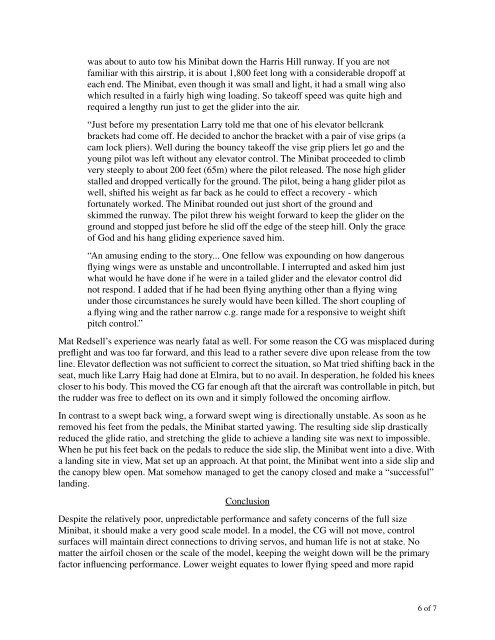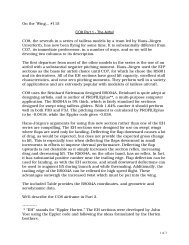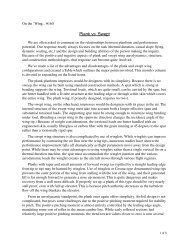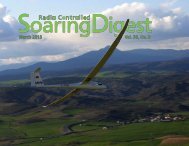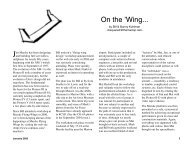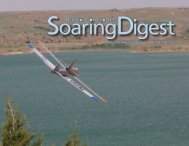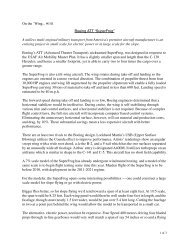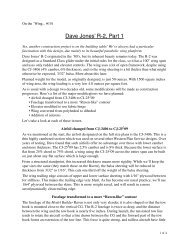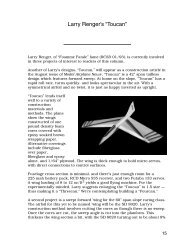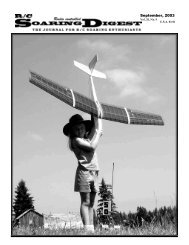Larry Haig's Minibat - Radio Controlled Soaring Digest
Larry Haig's Minibat - Radio Controlled Soaring Digest
Larry Haig's Minibat - Radio Controlled Soaring Digest
- No tags were found...
You also want an ePaper? Increase the reach of your titles
YUMPU automatically turns print PDFs into web optimized ePapers that Google loves.
was about to auto tow his <strong>Minibat</strong> down the Harris Hill runway. If you are notfamiliar with this airstrip, it is about 1,800 feet long with a considerable dropoff ateach end. The <strong>Minibat</strong>, even though it was small and light, it had a small wing alsowhich resulted in a fairly high wing loading. So takeoff speed was quite high andrequired a lengthy run just to get the glider into the air.“Just before my presentation <strong>Larry</strong> told me that one of his elevator bellcrankbrackets had come off. He decided to anchor the bracket with a pair of vise grips (acam lock pliers). Well during the bouncy takeoff the vise grip pliers let go and theyoung pilot was left without any elevator control. The <strong>Minibat</strong> proceeded to climbvery steeply to about 200 feet (65m) where the pilot released. The nose high gliderstalled and dropped vertically for the ground. The pilot, being a hang glider pilot aswell, shifted his weight as far back as he could to effect a recovery - whichfortunately worked. The <strong>Minibat</strong> rounded out just short of the ground andskimmed the runway. The pilot threw his weight forward to keep the glider on theground and stopped just before he slid off the edge of the steep hill. Only the graceof God and his hang gliding experience saved him.“An amusing ending to the story... One fellow was expounding on how dangerousflying wings were as unstable and uncontrollable. I interrupted and asked him justwhat would he have done if he were in a tailed glider and the elevator control didnot respond. I added that if he had been flying anything other than a flying wingunder those circumstances he surely would have been killed. The short coupling ofa flying wing and the rather narrow c.g. range made for a responsive to weight shiftpitch control.”Mat Redsell’s experience was nearly fatal as well. For some reason the CG was misplaced duringpreflight and was too far forward, and this lead to a rather severe dive upon release from the towline. Elevator deflection was not sufficient to correct the situation, so Mat tried shifting back in theseat, much like <strong>Larry</strong> Haig had done at Elmira, but to no avail. In desperation, he folded his kneescloser to his body. This moved the CG far enough aft that the aircraft was controllable in pitch, butthe rudder was free to deflect on its own and it simply followed the oncoming airflow.In contrast to a swept back wing, a forward swept wing is directionally unstable. As soon as heremoved his feet from the pedals, the <strong>Minibat</strong> started yawing. The resulting side slip drasticallyreduced the glide ratio, and stretching the glide to achieve a landing site was next to impossible.When he put his feet back on the pedals to reduce the side slip, the <strong>Minibat</strong> went into a dive. Witha landing site in view, Mat set up an approach. At that point, the <strong>Minibat</strong> went into a side slip andthe canopy blew open. Mat somehow managed to get the canopy closed and make a “successful”landing.ConclusionDespite the relatively poor, unpredictable performance and safety concerns of the full size<strong>Minibat</strong>, it should make a very good scale model. In a model, the CG will not move, controlsurfaces will maintain direct connections to driving servos, and human life is not at stake. Nomatter the airfoil chosen or the scale of the model, keeping the weight down will be the primaryfactor influencing performance. Lower weight equates to lower flying speed and more rapid6 of 7


